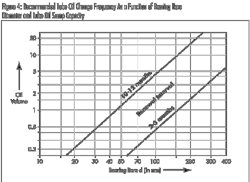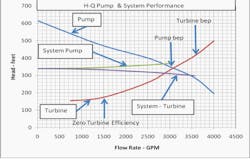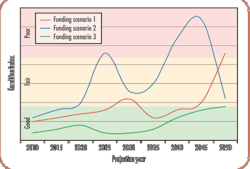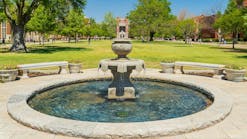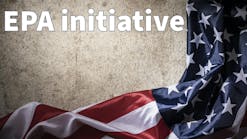With 60% of the country living below sea level, the Netherlands has developed sustainable water management systems to cope with changing weather patterns and extreme downpours. Green roofs and flood controlling water plazas are some of the measures helping Rotterdam to stay ahead of the game, says Linnie Mackenzie.
Booming populations, changing environments and increasing urbanisation have led to the need for cities to radically change in order to be future-proof. In order to build cities that are safe, sustainable, clean, accessible and environmentally friendly, a comprehensive overhaul is expected.
The sea level along the Dutch coast has already risen by approximately 20 centimeters over the past century; a cause of real concern for Rotterdam, a city situated some six meters below sea level. In a proactive approach to achieving sustainability, the Rotterdam Climate Proof (RCP) programme aims to achieve fully climate proof status for the city by 2025. The pivotal objective in this respect is the 50% reduction of harmful carbon dioxide emissions by 2025.
With an integrated plan that tackles the pressing issue of building sustainable urban water systems, Rotterdam hopes to successfully fight the consequences of climate change while positioning itself as a leading national and international water knowledge and climate city.
Rotterdam's Urban Water Systems
Water has both life-enhancing properties and destructive potential. It needs to be constantly managed, whether too scarce or too plentiful. Climate changed has changed the dynamics of the environment causing extreme downpours leading to flooded streets and basements occurring more often. The capacity of the city's existing drainage systems and pumping stations has become insufficient in coping during extreme rainfall. In addition, climate change has also brought about extended periods of drought in Rotterdam. The adaptation of the RCP programme aims to limit flooding in times of extreme weather events. To meet the current challenges, the city is taking a holistic approach that offers innovative solutions for the collection of rainwater from roofs and other impermeable surfaces as well as the separation of dirt and leaves from the rainwater that has been collected.
Netherlands' largest underground water storage facilities, capable of holding 10 million litres
The construction of additional water storage facilities and water plazas, and the provision of incentives for green roofs, all help to preserve the optimal quality of life in the city despite the drastic climate change. These initiatives involve innovative alternatives for water storage, solutions for water collection during heavy downpours (emergency storage), and options to delay the discharge of rainwater. The aim is that even during dry periods the city will have water of a sufficient quality.
RainWater Harvesting - Green Roofs
Water storage in Rotterdam is integrated in the urban environment wherever possible; collectively encouraging the installation of green roofs. The large-scale application of green roofs contributes to a more sustainable, healthy city. During heavy rainfall, these green roofs provide a valuable solution for temporary water storage. It absorbs precipitation, reducing the speed of rainwater runoff and delaying the peak in discharge. As a result, the pressure on the sewerage system is reduced in times of heavy rainfall.
For large roof areas, it is best to use a siphonic system to discharge and collect the rainwater quickly and in a cost-effective manner. One of the major benefits of a siphonic system is that the horizontal pipe runs do not have any fall, minimising the space required to accommodate the system. This provides the designer with the freedom to route the pipes to any location at high level, before dropping to ground level.
The high suction in the system reduces the pipe diameters and number of vertical drops needed compared to a gravity system, providing a reduction in cost for most installations. The major advantage of a siphonic system is that drainage can be taken to the end of the building, removing the need for almost all under slab drains.
Rotterdam promotes the installation of green roofs in several ways. It is mandatory for municipal properties, for example, to be provided with a green roof.
The installation of green roofs on third-party buildings, such as the premises of housing associations, is also encouraged. In 2008 and 2009, these efforts resulted in the installation of green roofs on the Municipal Archives, the Central Library, the Delfshaven and IJsselmonde/Feijenoord docks and Sophia Children's Hospital.
A number of additional projects are currently under construction as well, including the installation of green roofs for Erasmus MC, the head office of ROTEB Kleinpolder (Department of Cleansing, Disinfection, Transport and Workshop Rotterdam), the municipal pumping plants and the Zoomstraat car park.
With the aim of encouraging the installation of green roofs on privately-owned buildings, the City of Rotterdam has a subsidy scheme in place since July 2008 where €30 is given for every square meter of green roof installed.
Water Plazas (Watersquares)
The city is also studying possible locations for the construction of water plazas. These water plazas will fill up in a controlled manner during heavy rainfall, preventing surrounding streets from flooding. In dry periods, these water plazas can be effectively used as open public spaces. DeUrbanisten, a Rotterdam-based architecture firm specialising in water related urbanisation, sustainable cities and the design of public spaces, was tasked with the project of designing such a space.
Known as the watersquare because of its shape, the design is presented in two main parts: a sports field and a hilly playfield. The sports field is sunken into the ground by one meter and is surrounded by steps which also functions as a grandstand where spectators can sit and watch a game. The playfield compromises of several spaces that are set at different levels where people can sit and have a relaxing picnic or where children can play. Both parts are enclosed within a green frame of grass and trees which borders the square.
During drier months of the year, the watersquare will be used as recreational space. It is only during times of heavy rainfall will the watersquare change its appearance and function. Design ensures that the spaces flood in a gradual manner and collected rainwater flows into the watersquare and fill different parts of the hilly playfields.
Rainwater remains in the watersquare until it can be discharged into the nearest water body. Short cloudbursts create streams, brooklets and small ponds that allow children to play in and around the water. During prolonged downpours, the watersquare will gradually fill up until the sports fields are flooded and the square becomes purely a water storage basin. It is expected to hold a maximum of 1000 cubic metres of rainwater.
It is worth noting that the watersquare is not a sewage treatment facility - it will only require a clean sewerage system of rainwater. It can also be used in combination with the green roofs whereby rainwater is collected and filtered in a separate clean water system, which then takes it from roofs to the watersquare. A pilot scheme for a watersquare is currently being examined, designed and developed for Rotterdam. At the same time, a survey on the best suitable pilot locations for the square is being executed and construction is set to begin in 2011.
Multifunctional Car Parks
Other storage applications involve multifunctional car parks. The new car park near the Museumpark, for instance, will be equipped with an underground water storage facility touted to become the largest water storage facilities in the Netherlands. Under the entrance to the Museumpark, an underground water storage is being constructed for sewage, with an extra capacity of 10,000 m3.
Whenever heavy rains threaten to cause the sewerage system in the centre to overflow, within thirty minutes, 10 million litres of rainwater will flow into the water storage. When the downpour is over, the rainwater will be pumped into the sewers and discharged in the usual manner. The car park and water storage are scheduled for completion this year.
Projects like these are deployed by Rotterdam to increase the storage capacity of the existing sewerage system, and take some stress of the current sewage system. The city's present sewage system will no longer be burdened; preventing contaminated sewage water from overflowing into moats and canals.
The Dutch Approach
Flooding caused by increasing rainfall will need at least 80 hectares of extra open water bodies such as lakes and canals in order to cope with the shortage requirements. When space is limited, the focus is on alternative ways of retaining and harvesting rainwater. The maintenance of a pristine quality of water is also of utmost importance and should be addressed by private and public actors involved.
Following the European Framework Directive on Water, Rotterdam is working towards improving existing open areas of water through the use of collective measures. In the near future, the city plans to segregate the current sewerage system in order to establish a system where wastewater can be separated from relatively clean rainwater.
There is no denying that water is an important means by which the quality of Rotterdam as an attractive city is established. Together with various partners and the right expertise, Rotterdam aims to strengthen its position as the water city of the future. With a holistic approach to managing the city's urban water systems, Rotterdam serves as a stellar example as to how delta cities can cope with the changing environment.
Author's note: Linnie Mackenzie is area director of the Netherlands Foreign Investment Agency, an operational unit of the Ministry of Economic Affairs. For more information, please email: [email protected]
More Water & WasteWater International Current Issue Articles
More Water & WasteWater International Archives Issue Articles
